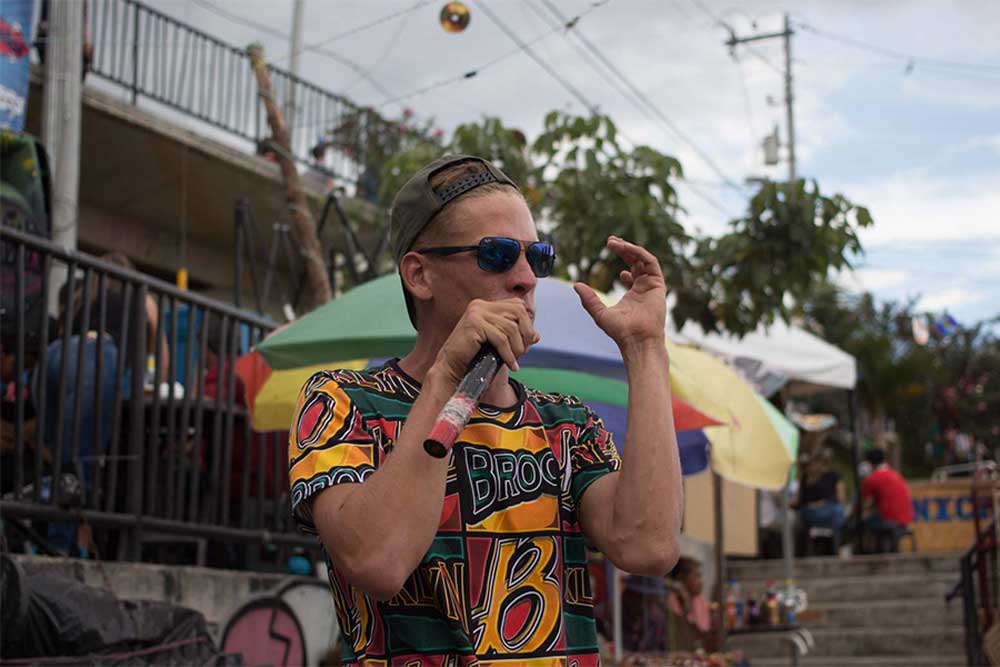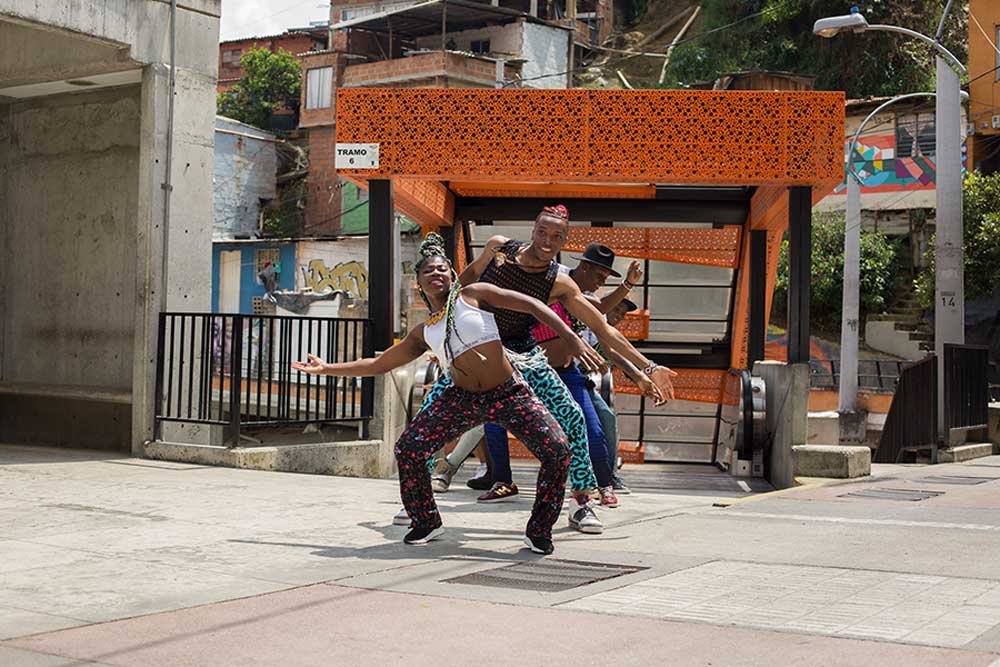Spray paint, Beats and Reggaeton
The most innovative city in the country is also one of the reggaeton world capitals. The strength of these rhythms has a long history and deep roots in the city. From the communes, the center and the exclusive south, Medellin is the sum of voices that narrate the city center and colors that cover its walls in a transformative appropriation of urban space.
“Urban”, the surname that Medellin has adopted not only responds to the obvious fact it has grown into a metropolis, but rather to the forms of appropriation of its public spaces. The streets, which were once denied to its dwellers, are being recovered, acquiring new mmeaning in a process that is taking place through art. Changing silence for the overpowering sounds of rap, modifying the cautious steps for the perreo of reggaeton and bringing art out of museums and putting it outside for everyone to see.
Color Has Taken over the Walls
This means, for example, that you just have to get off at any subway station and walk a bit to face multicolored walls. However, the best option to see these works of art is to ride the subway, get off at the San Javier station and go into Commune 13. There, local guides speak about the tough past of the commune, with the walls intervened in the background; walls that record the history of the different versions of Medellin that have inhabited, walls that appear as a symbol of what was and what is to come. There, have been as nowhere else, you can see that gray streets are left behind to give way to diverse narratives and voices that tell new stories.
The road to Commune 13 is steep. So much that the mayor’s office built escalators for the inhabitants of the sector—there used to be 400 steps they had to climb and descend to go home, and even used sliding boards to get down. You have to start climbing, and local art takes that ascent to a very high point with extraordinary graffiti and murals.
One of the first graffiti seen at the beginning of the tour is a pink wall with a woman’s face on it bearing colored figures on her skin symbolizing diversity: orange, blue, green, yellow. On her shoulder sits a white dove and on her torso symbols like hearts and shoes that speak of a new path. There are also graffiti of peacocks spreading their feathers in corners, lions and gorillas, powerful hands that throw dice on houses, unforgettable dates for the area and faces of women with hair made of water
Here, the balconies of the houses are painted and the most daring even paint the façades of the first floors. You just have to look out from some high vantage point in the neighborhood, or look down to where the escalators end, to see that the roofs are also used as canvases. Here, everything is painted and each line contains messages that can be summarized in one, a message of recovery by the city: this is also mine. The entrances of ice cream parlors that sell traditional ripe mango ice cream or the barber shops where experts create intricate on customers’ heads, are also painted.
With over 600 graffiti, this area of Medellin is the most intervened; however, you can’t walk many blocks in the city without finding urban art manifestations left and right. That can range from bombings and tags, which are the artists’ ways of signing the graffiti, to mural art and everything that fits in between. This is due to tireless artists who set up scaffolding and use up spray paint cans to make their art, but also to festivals, organizations and groups that have been in charge of helping their voices get heard.
You may also be interested: Five Reasons to Take a Graffiti Tour in Bogota
Did you know that a Medellin radio station played the first reggaeton song ever heard in Colombia?
The Living Voices of Medellin
Another manifestation of the urban concept that Medellinians have found to claim ownership of their streets has been rap. MCs that sing to those who are alive and remember those who are no longer here and who, with clever beats, celebrate every day, while telling the stories that precede them. The inspiration of local rap is right there, in their ownership, in the neighborhood, in words that seem to only be said, or understood, in a certain way, between the mountains that enclose Medellin.
Nea, parce, farra, estrén, chichipato, visaje, bell, sleeve, mostro, key, flag, azara, no azara. These words intermingled in Paisa rap can be heard on headphones, but even better if they are heard live, in the street. The owners of improv or freestyle every so often set up lyrical confrontations in skate parks, courts, parks or houses, like fighting cocks. In these “battles” away from violence, the only possible weapons are words turned into rhymes, concentration and a tuned ear.



Dance and rap are more alive than ever in the streets of the capital of Antioquia.
Without straying too much from what the Antioqueño troubadours do, the scenario can be anything at all, but the formation remains: one rapper facing the other, waiting to be attacked with rhymes aand— around them, close by in absence of a stage—the spectators. These latter seldom care about personal space and are ready to get closer and closer to the action in order to avoid missing the viper stikes the rappers exchange. There is no record and if there were, it is not meant to stick. Freestyle is made just for the moment.
There are also songs that become hymns of the people and which in turn are panoramic photographs of Medellin seen from inside, the locals sing and listen to them to feel at home and go to festivals, concerts and presentations with the intention of experiencing rap firsthand for what it is: a manifestation of their own selves. They go to listen to stories, to the now and to what comes later with the streets they occupy. The rappers of Medellin and their songs can proclaim themselves prophets in their own land. Dance now ensues.
You may also be interested: Medellín, spring, rhythms and year-round style
Did you know that reggaeton contributes nearly 90% of the Colombian music industry’s income?
Reggaeton: the Language of a Generation
Reggaeton has several maternal homes. Panama saw its birth when reggae in Spanish combined with hip hop. Puerto Rico welcomed it as its own, made it recognizable and recognized throughout the world. Then it arrived in Medellin, a little later, and was established as an industry: in this city, reggaeton is sung, reggaeton is produced, its videos are made and negotiaded, but above all, reggaeton is danced.
Nightclubs do not differ much from each other: they are dark places with neon-colored lights that make the shadows brighter and skins look of a single color. There are clubs scattered throughout the city, although those located in El Poblado are the busiest. You go to these places to understand under what rhythm Medellin is dancing: a catchy and hot one.
There is almost always a bar very few tables because the space for the perreo is needed, so that the bodies of women and men can move to the rhythm of the reggaeton’s own dembow, which can be smooth or can lead to exaggerated and wild movements. Regardless of the swiftness of the rhythm, some steps and poses usually remain: hips stuck together and moving side to side, torsos dropping as if they wanted to reach the ground: everyone goes down.
Many of the rhythms and songs that are danced in Medellin are composed right there. A robust and constantly expanding industry is composing and producing reggaeton, marketing it, creating the images with which it is projected and the videos with which it is viralized. There are artists from Medellin like J Balvin, Maluma and Karol G who are making the genre travel throughout the world at incredible speeds, and who find in the city all of the tools needed to make their songs possible. Medellin is fertile ground for reggaeton.
In addition to being tools with which Medellinians have claimed the streets, graffiti, rap and reggaeton seem to have no borders of any kind. The whole city lives them, shares them and everyone gathers around them. There is no unpainted neighborhood, without at least one house where they take speakers out to thunder rap, and without someone swaying to reggaeton. Urban art summons the city from all sensibilities and brings it together as few things will ever. Therefore, again, to really get to know Medellin, you have to walk the street with eager eyes, attentive ears and bodies sensitive to the urban rhythm.
Text by Andrea Uribe Yepes














